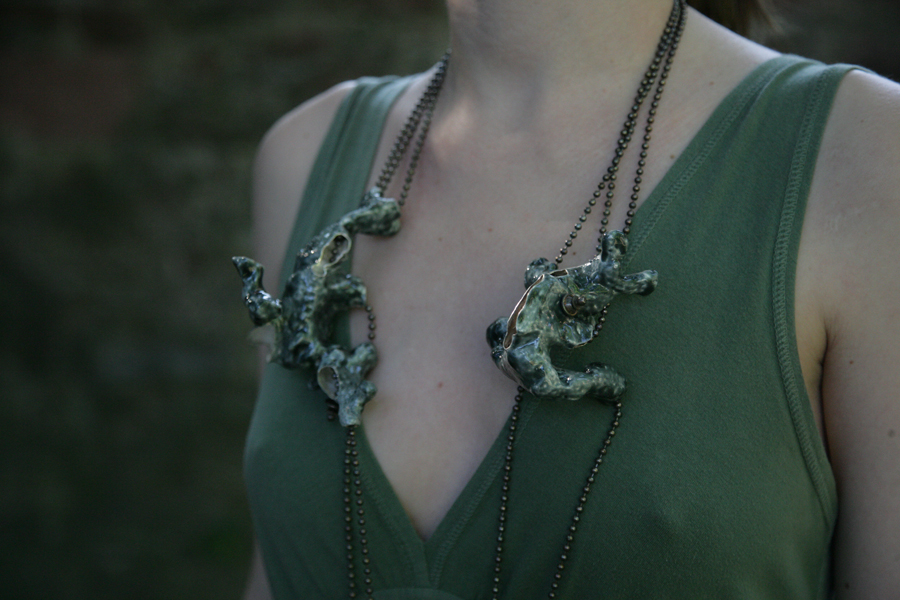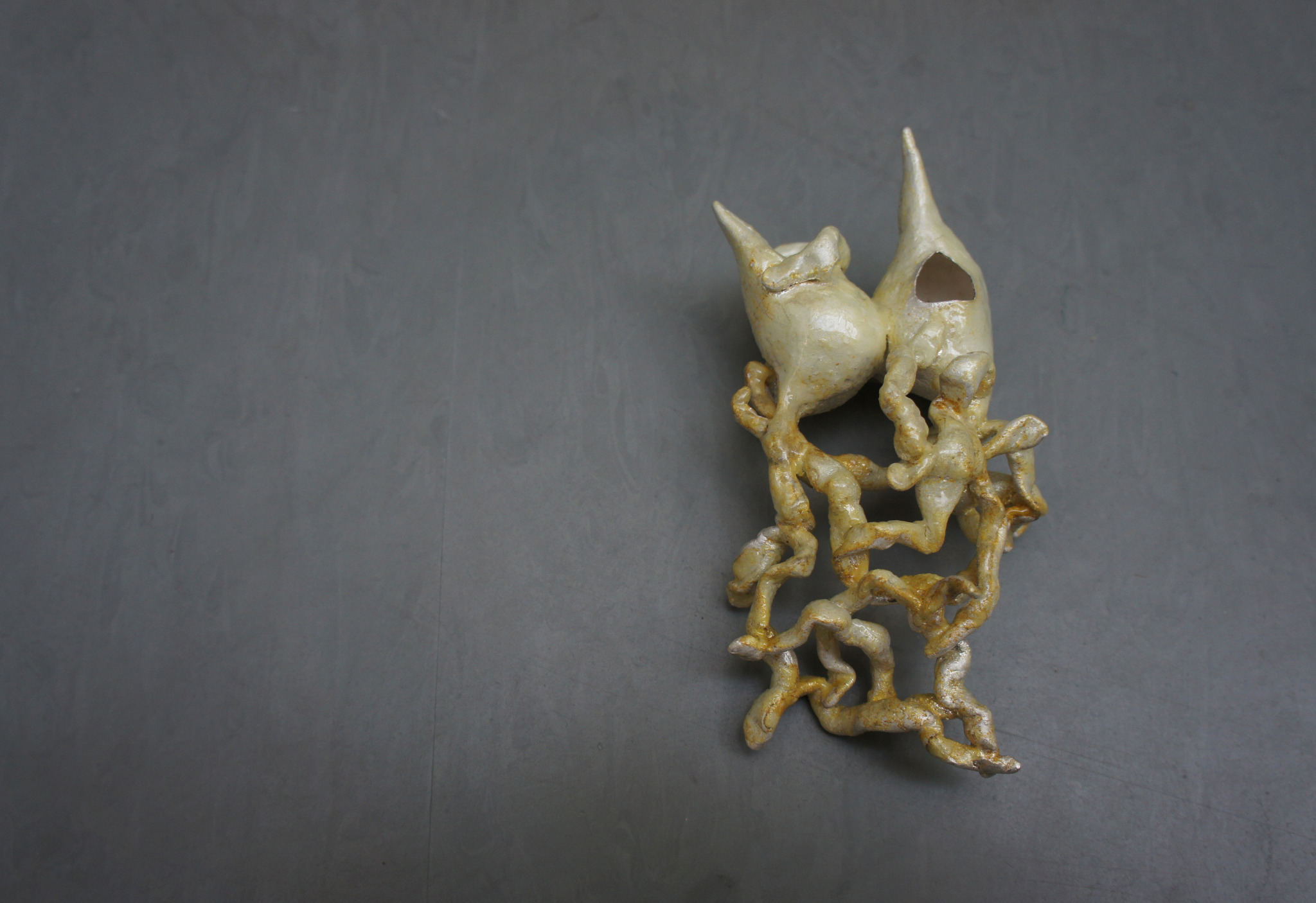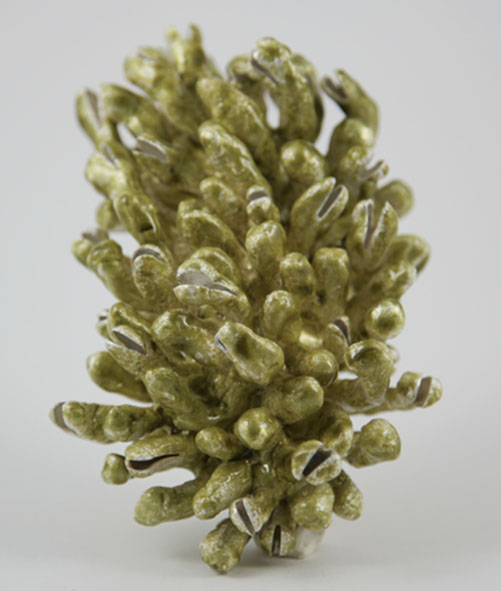sanctionary badge
2023
A sequel, DIY project, following the previous work “vom Abzeichen zum Auszeichnen”
For a deeper insight, please read my peer reviewed essay “The World-Shifting Qualities of Adornment”
for The Vessel magazine of Norwegian Crafts - issue 5, “The Outermost Layer“, 2023
![]()
For a deeper insight, please read my peer reviewed essay “The World-Shifting Qualities of Adornment”
for The Vessel magazine of Norwegian Crafts - issue 5, “The Outermost Layer“, 2023

vom Abzeichen zum Auszeichnen
2020-2022
badges
series #1: black anodized & coated aluminum, stainless steel
series #2: casted aluminum, stainless steel
For the PhD enquiry “Pharmakos”,
research was conducted at historical archives, where cases of social injustice and oppression had been documented. The investigation looked into the design evolution of wearable signs, worn as indicators to systematize and marginalize human bodies during the WWII.
The work draws its title from administration letters of the time and it appropriates and subverts the black triangle ; a sign which was assigned to any prisoner classified as “asocial”. Thus, the work attempts to reverse it into an honouring distinction.
Historically, the pink triangle is a well-known protest emblem used by LGBTQ+ movements. That too, was invented by the Nazis as a derogating sign against homosexuals. A lesser-known aspect though, is that the pink triangle was assigned to men only. When homosexual female bodies had to be classified, then they were indexed into the “asocial” group. A grouping which targeted numerous sub-identities that spanned from homeless to non-conformist women to any behaviour that transgressed the top-down guidelines. The black triangle is considered historically the most feminized category of the WWII.
Following common strategies of socio-political dissent, such as appropriation and subversion, and while acknowledging similar locations of thought emerging globally today, the work proposes statement-pieces that speak of resilience, emancipation and self-determination of the female body and the social body.
2020 / Vivi Touloumidi
PAUL PANDA FARNANA PRIZE 2023-2024
For a deeper insight into the project, please read:
artist book
“PHARMAKOS,
ADORNMENT AS A SOCIAL TOOL”
2022, Track Report series,
limited edition 300 copies
10. April - 15. June 2022
M HKA museum, INBOX
9. December 2022 - 8. January 2023
![]()
photo: M HKA
The badge of series #1 was the artwork for the
PAUL PANDA FARNANA PRIZE 2023-2024 In response to the first series of badges in black anodized aluminum, series#2 was created to be set in dialogue with. Though they belong both to the same project and share the same title, the pieces of series #2 were created in casted aluminum, drawn intuitively by the use of flame. Stripped by the use of color, they are still making links back to plain metal tags used during WWII. Their organic and bodily references reflect the content of the project, while they are complementing the industrial mechanic aesthetic of series#1.
2022 / Vivi Touloumidi
For a deeper insight into the project, please read:
article
FORUM+artist book
“PHARMAKOS, ADORNMENT AS A SOCIAL TOOL”
2022, Track Report series,
limited edition 300 copies
solo exhibitions
MARZEE gallery10. April - 15. June 2022
M HKA museum, INBOX
9. December 2022 - 8. January 2023
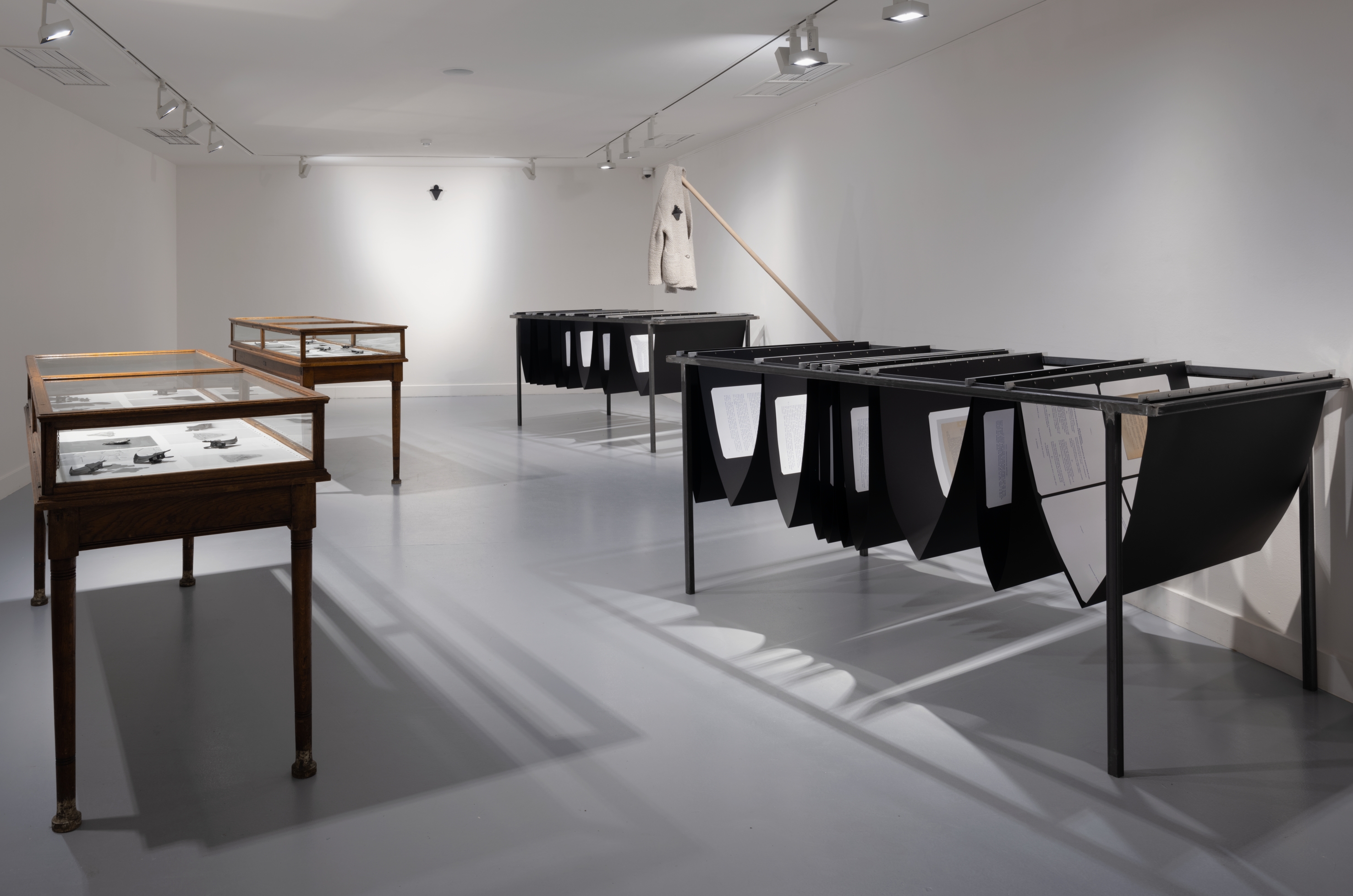
public collection:
• Schmuckmuseum Pforzheim, DE, 2022
publications:
• Madrugada, biennale catalogue,
MUDE - Museu do Design, Lisbon, PT, 2024
• KORU 7, International Contemporary Jewellery,
exhibition catalogue, Lappeenranta, FI, 2021
• 350 Words for Jewellery, B.Schmidt, book, Munich, DE, 2022
• Die Mysterien der Zeichen, Arnoldsche Art Publishers, DE, 2022• HART magazine, “Method in the Madness” by Vincent Van Meenen, No. 221, p.67, BE, 2022
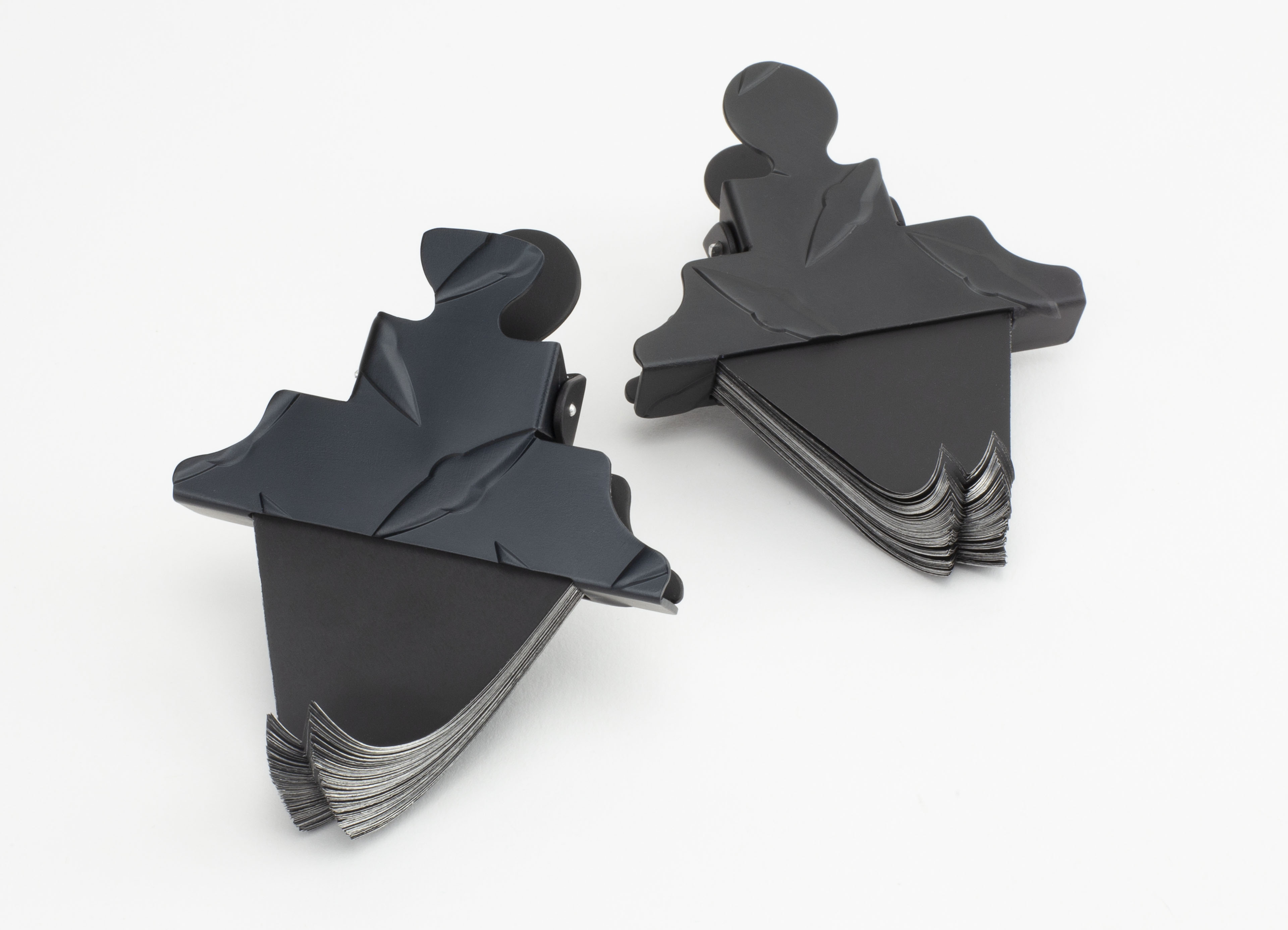
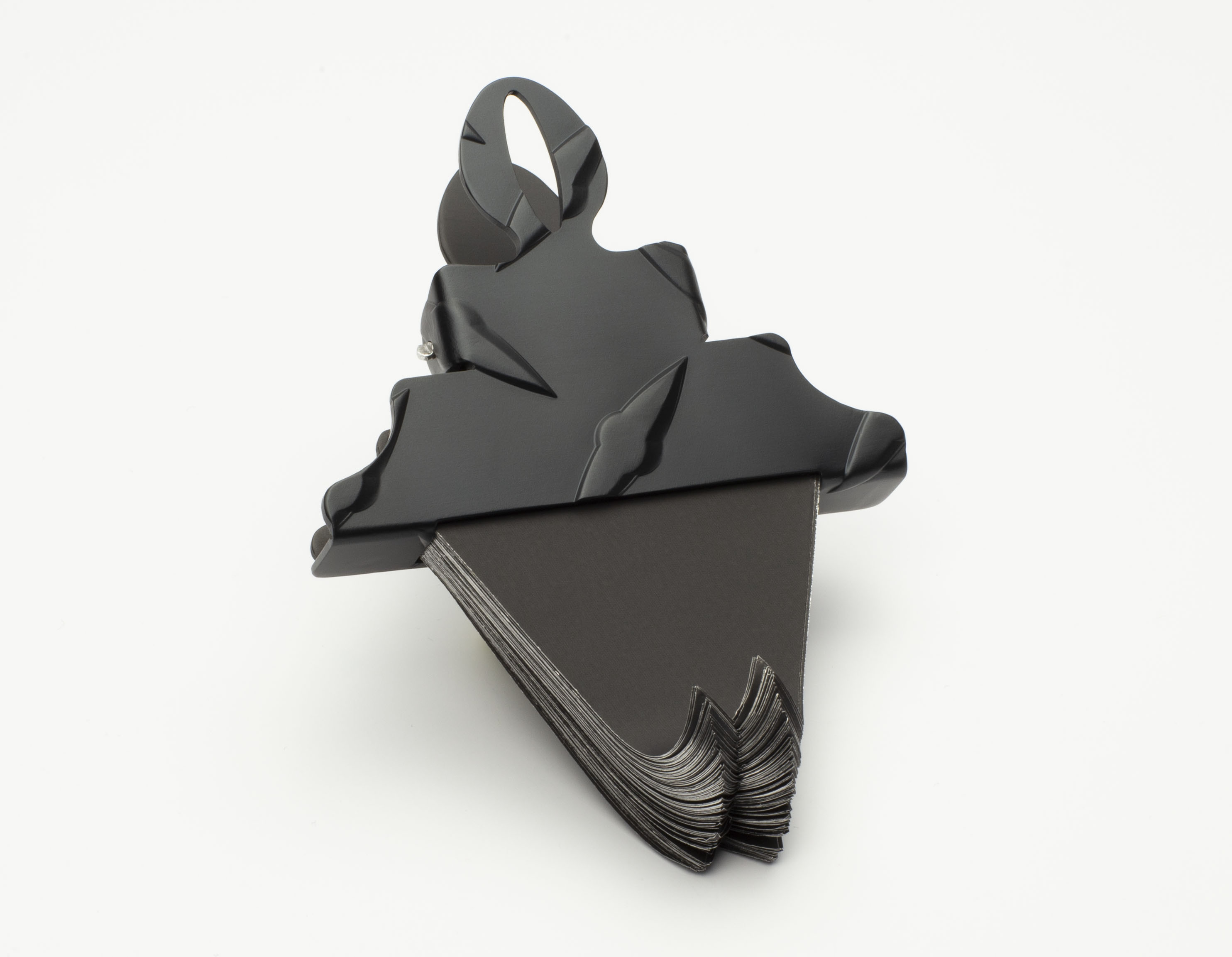
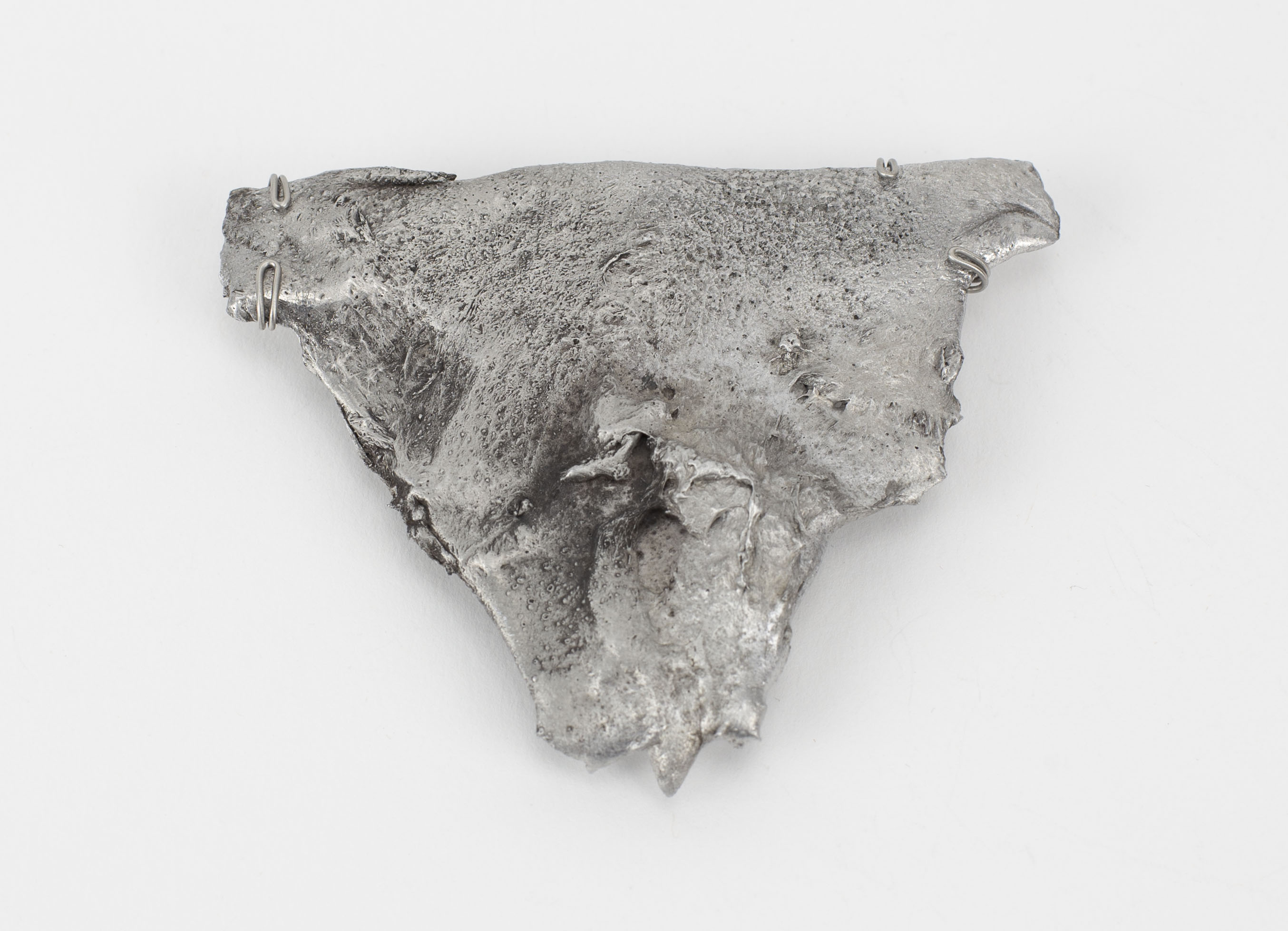
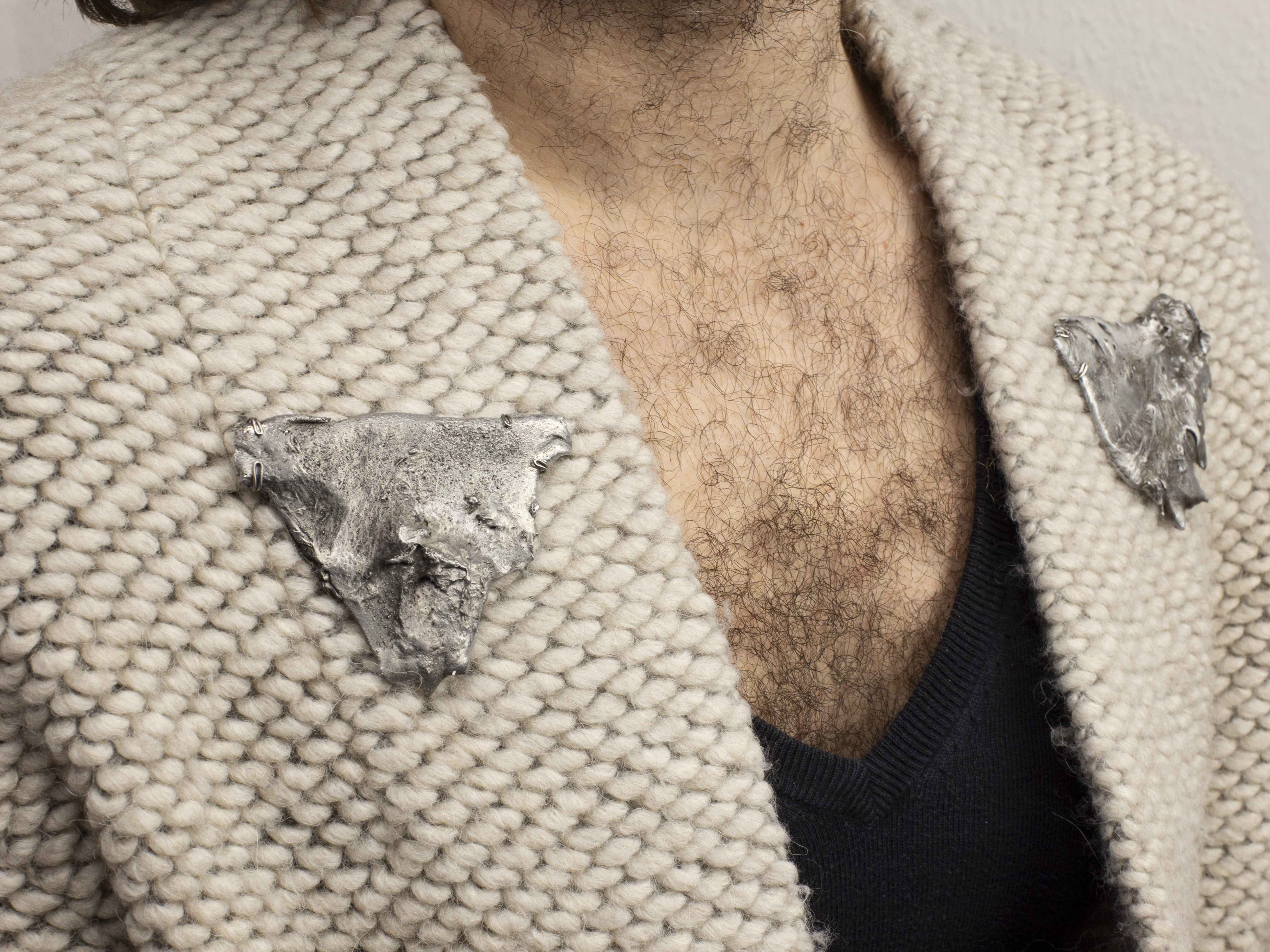


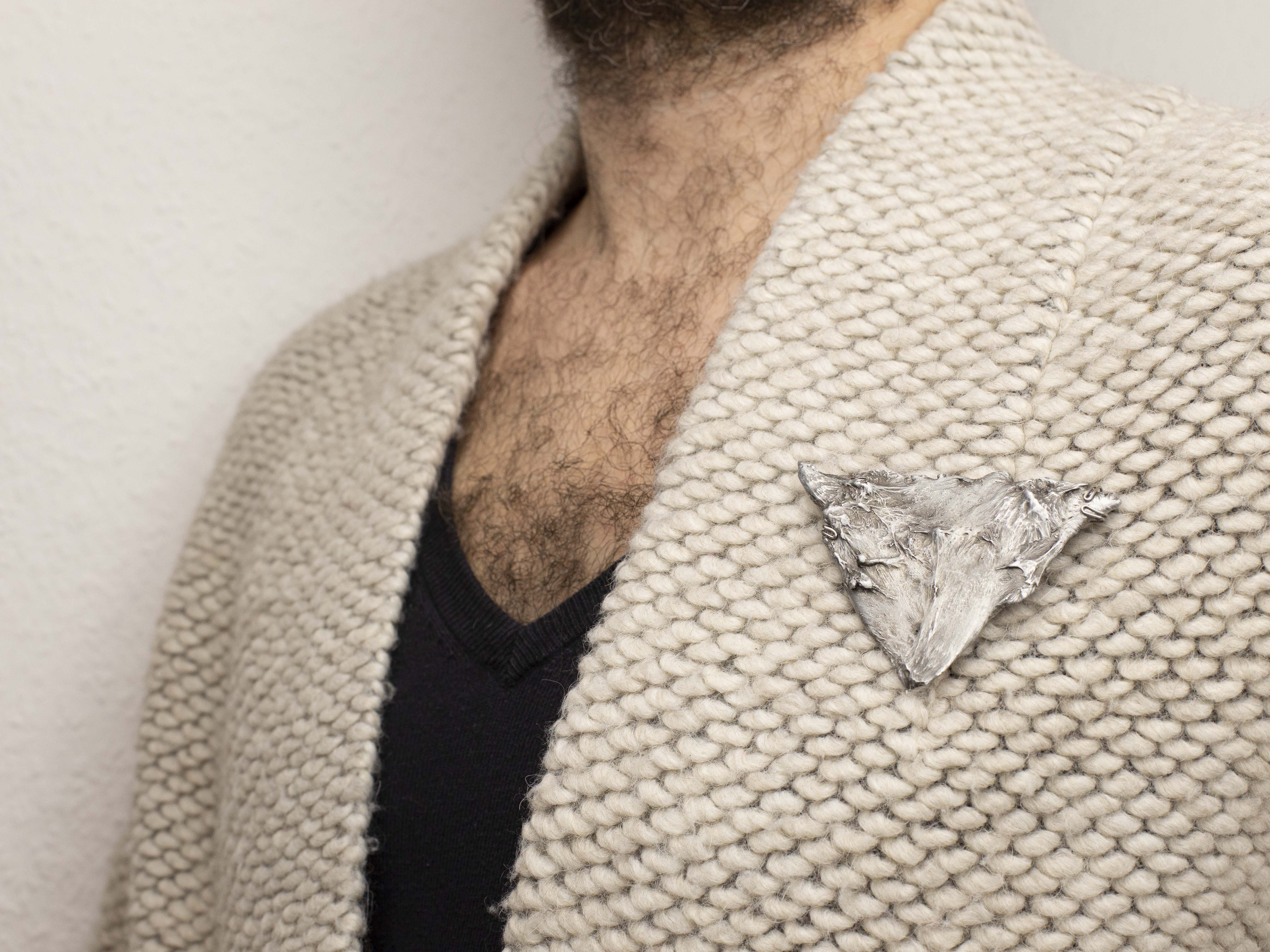
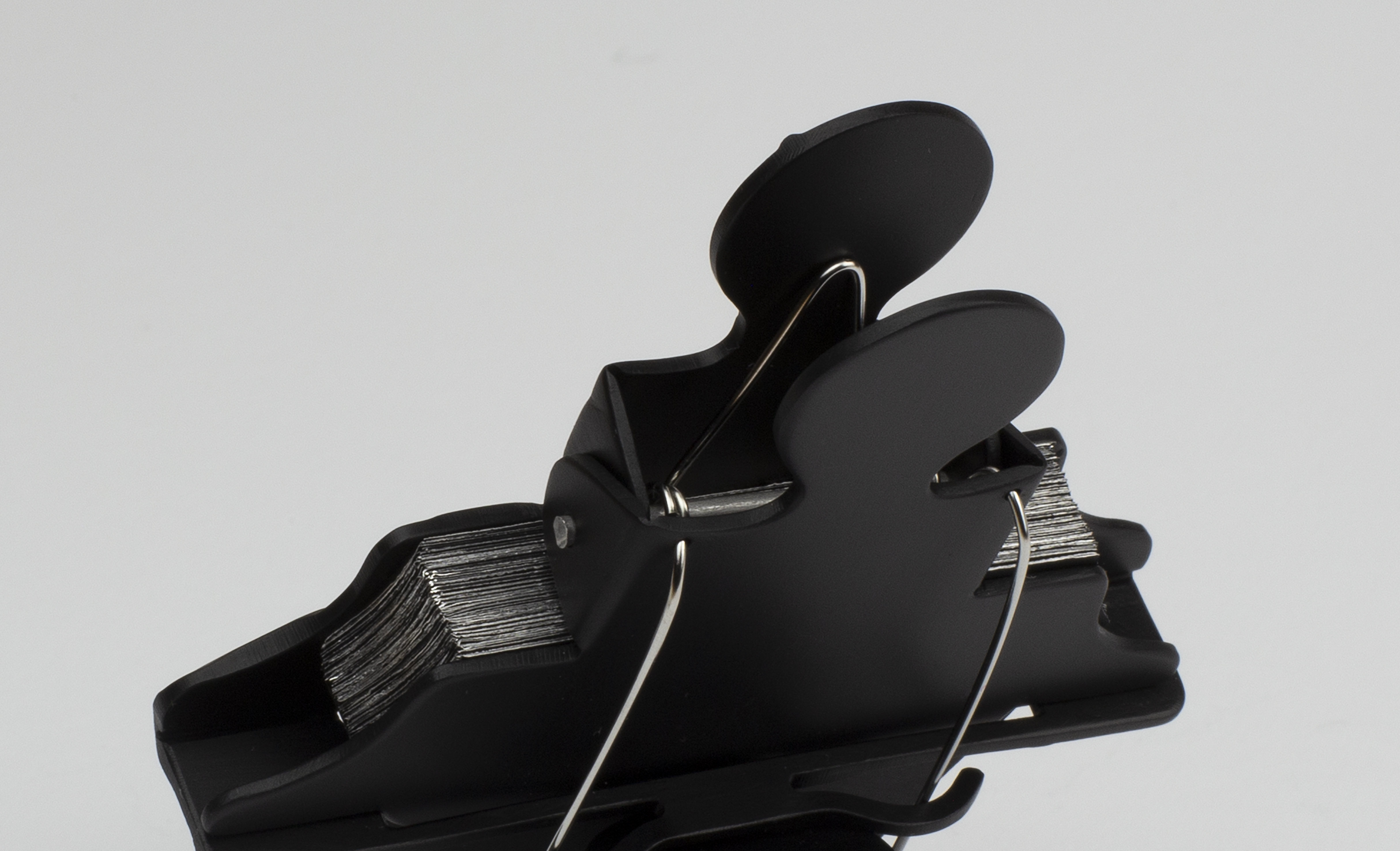

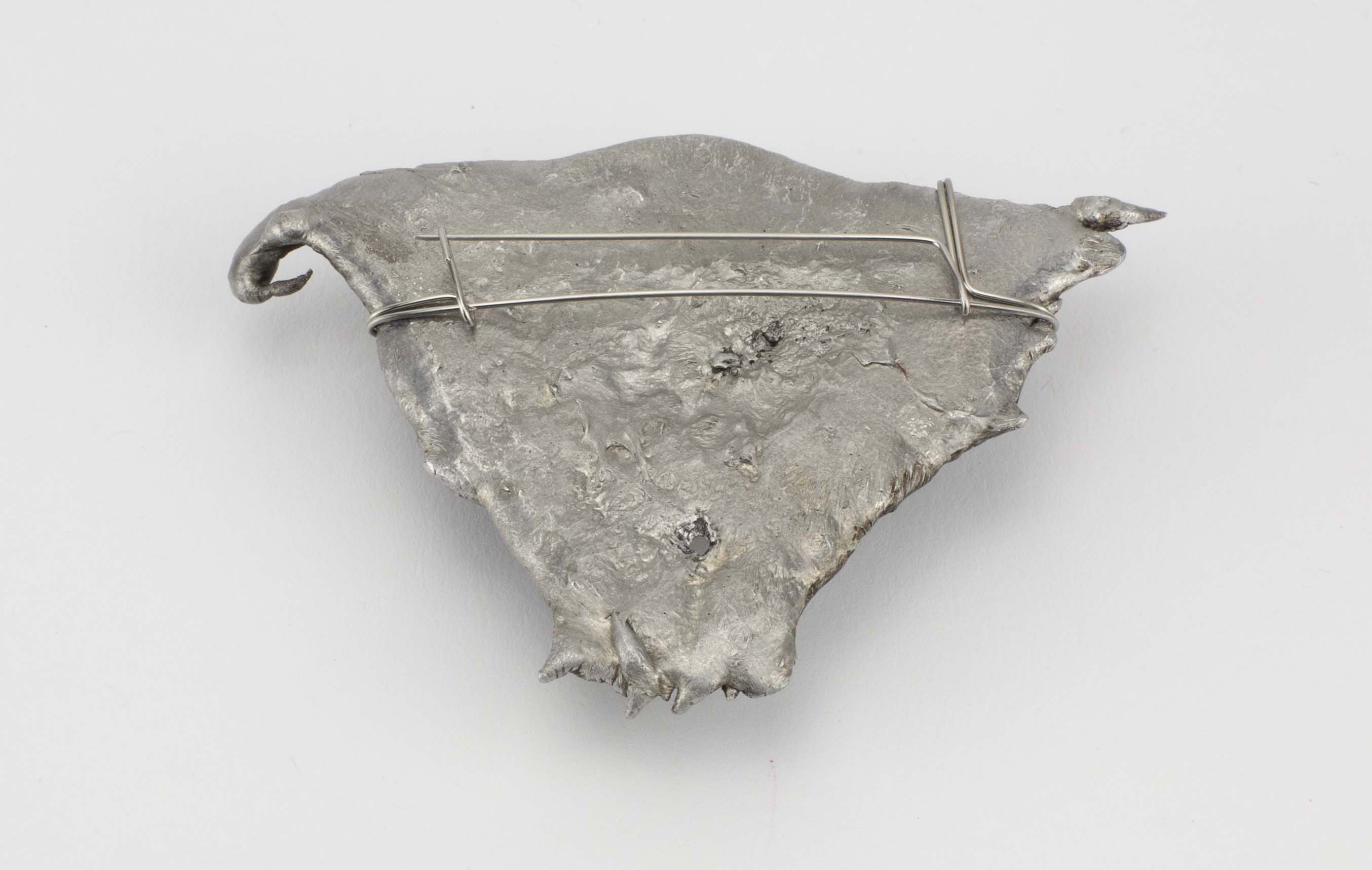
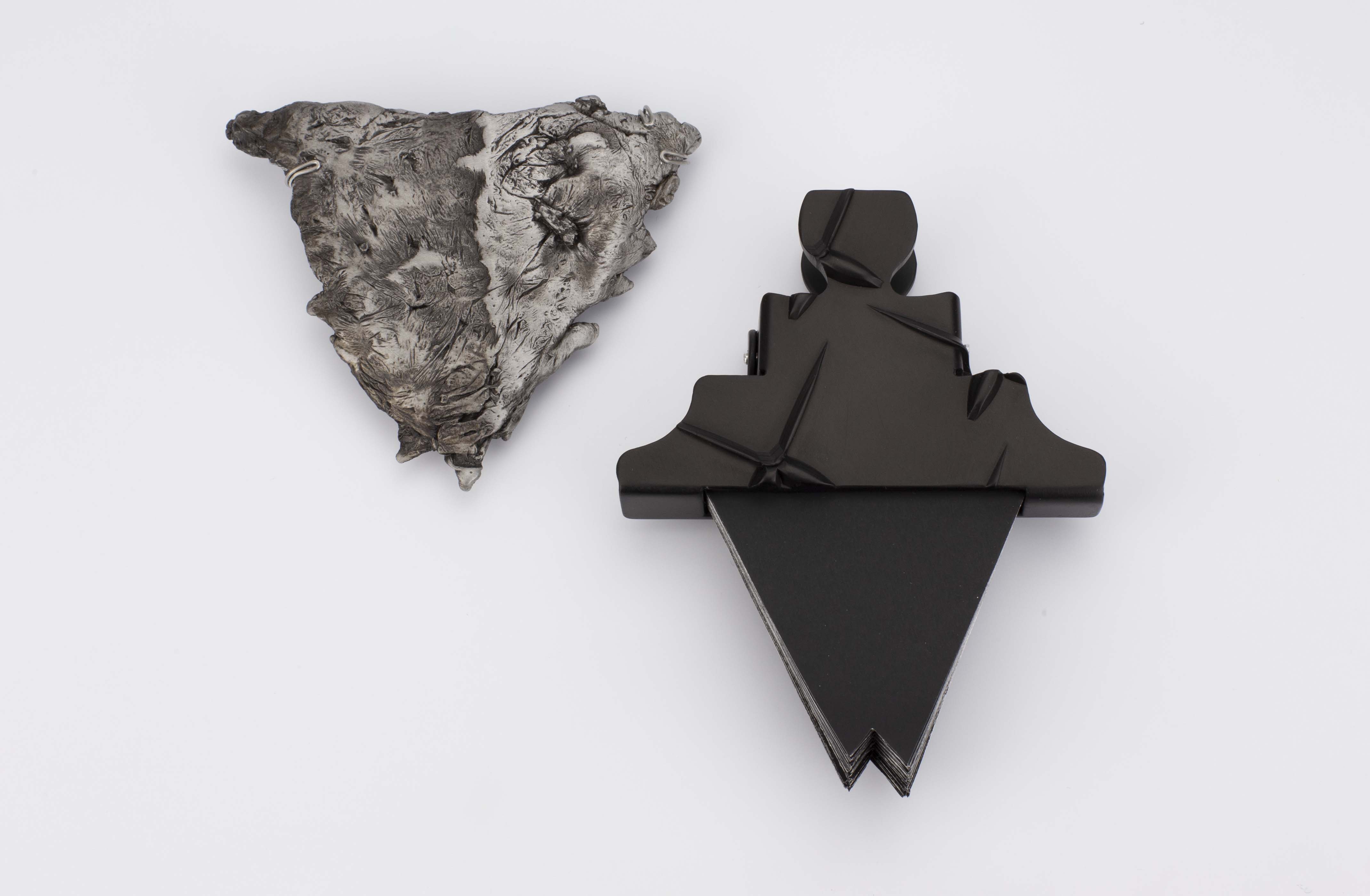
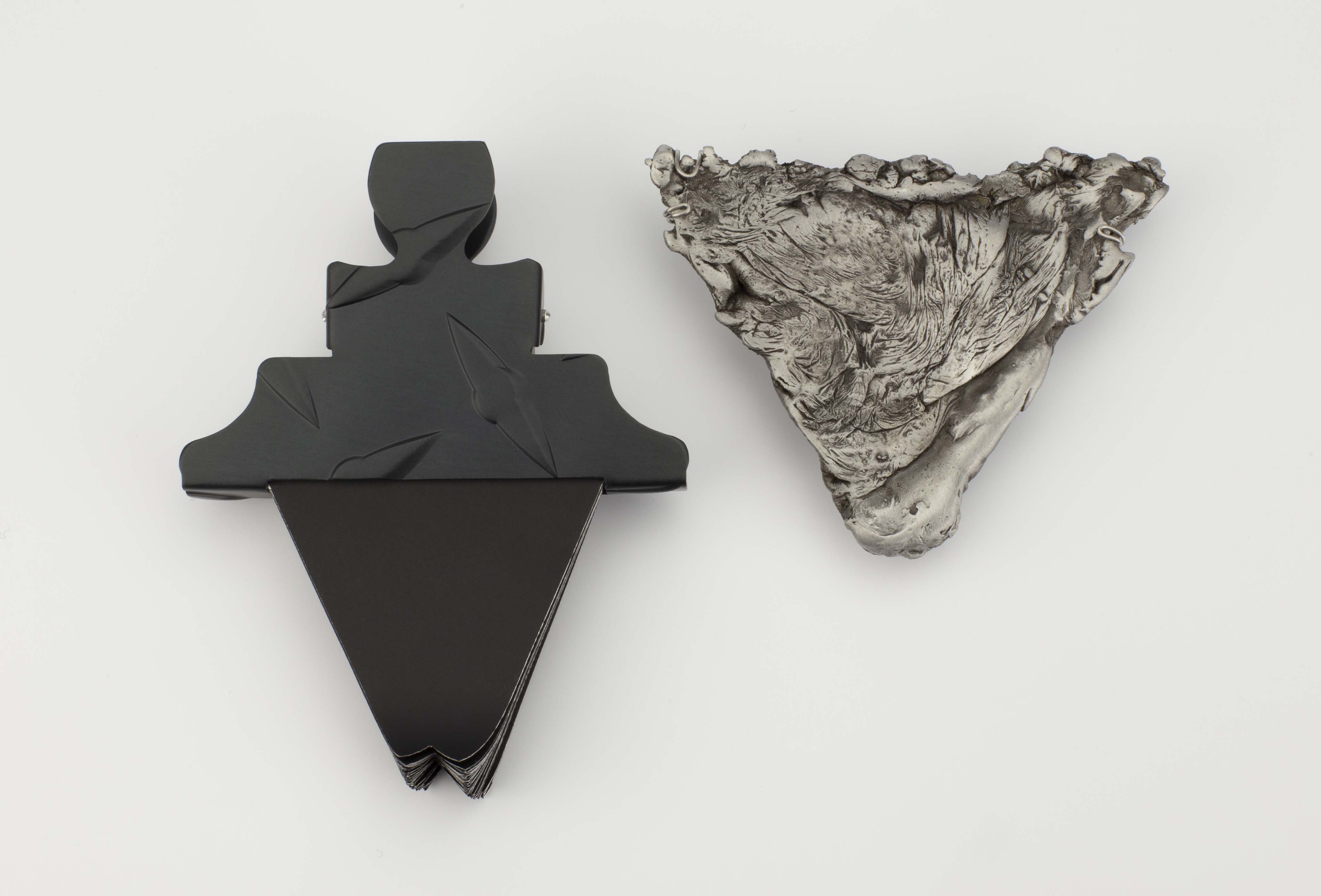
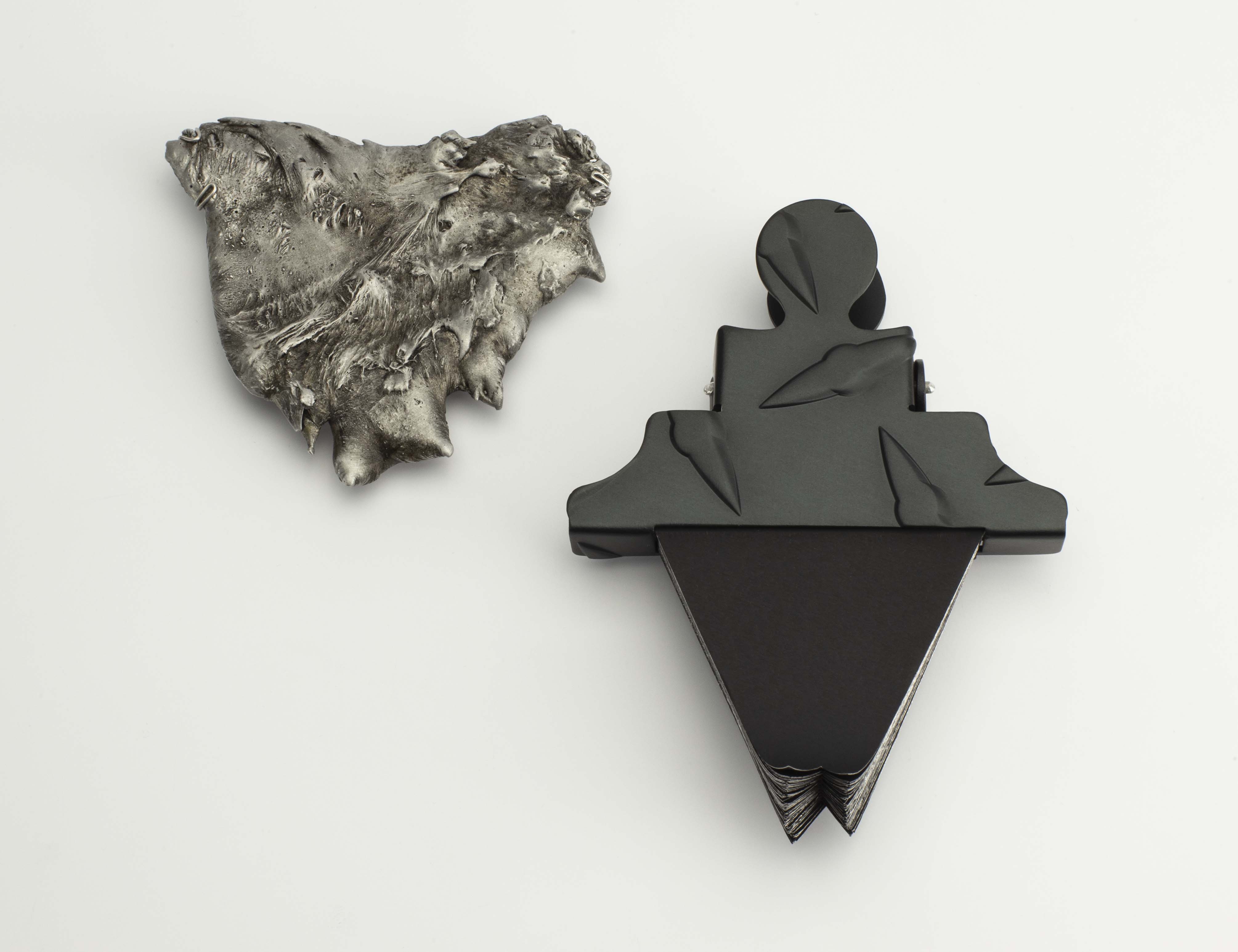

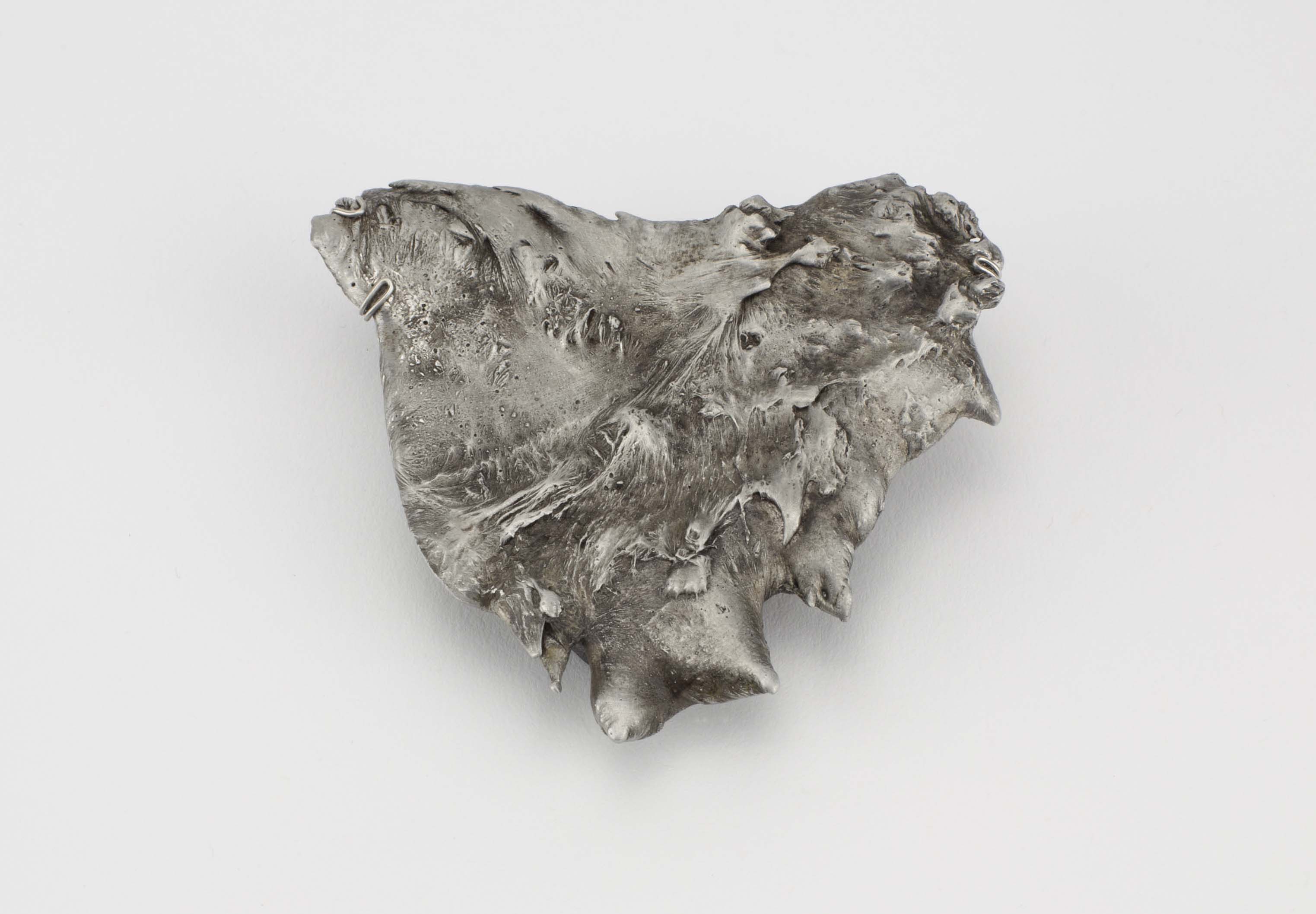

Parerga
2017-2019
brooches, re-purposed casting sprues
in bronze and nickel silver, stainless steel
>> In my jewellery series “Parerga”, I re-purposed casting sprues of sculptures into wearable pieces for the body. As the title implies, the project comments on the discipline devision between the fine and the applied arts as also the hierarchies imposed on them.
Parergo derives from the Greek language and refers to the element that stands next (par) to the main work (-ergo).
The word can describe a subordinate activity in addition to the original vocation, but it can also depict an accessory supplementing a larger and greater work.
In art history often the embellishment next to the central subject of an art piece has been called a parergo. The term has been coined by Kant in “Critique of Practical Reason” to discuss the ornamentation (Zieraten) around the main work, using as an example the gold gilded frame that surrounds the prime artwork, the painting. >>

In parallel to my main art jewellery practice I freelanced at a sculpture foundry in Berlin, casting large scale artworks in bronze, nickel silver and aluminum for the international art market. Involved in the production of Fine Art works for the worldwide art arena I observed how the art industry structures are build and I reflected on the separation among the art and craft practices.
The craft of casting large artworks employs a complex sprue system through which the liquid metal is channelled into the mould of the sculpture’s main body. The irregular structures grown on the surface of the sprues are random errors, generated during this casting process. These sprues are the last supporting elements to be detached from the final art pieces. I repurposed them further into wearable art pieces for the body by forging them into shapes that resemble gilded frames, linking them back the idea of a “parergo”.
Derrida deconstructed the term further in “The Truth in Painting”, where he investigated the relationship between the work of art, its frame, and its milieu in the visual arts. He interpreted the frame literally, as the physical boundary between the painting and its surroundings, but also metaphorically, drawing attention to the work’s cultural context. >>

The parergo puts the work in perspective, it is an action of reflective thought through isolation.Its function is to contextualise what is being framed, to make meaning. A frame is simultaneously the limit to a beginning and to an end, it protects its content and exposes it at the same time.
Craft is embedded within art creation, it is its core component.
Recent craft theory has engaged with the idea of the parergo due to its decorative function. But if it is the frame that puts the work in context and supports its meaning, then as Derrida argues, a painting needs its frame as much as a frame needs its painting.
The sprues are transformed into wearable art pieces for the body by forging them into frames of an empty content.
And what a frame is to a work of art, this is what jewellery becomes for the body. It signifies context.
2017 / Vivi Touloumidi

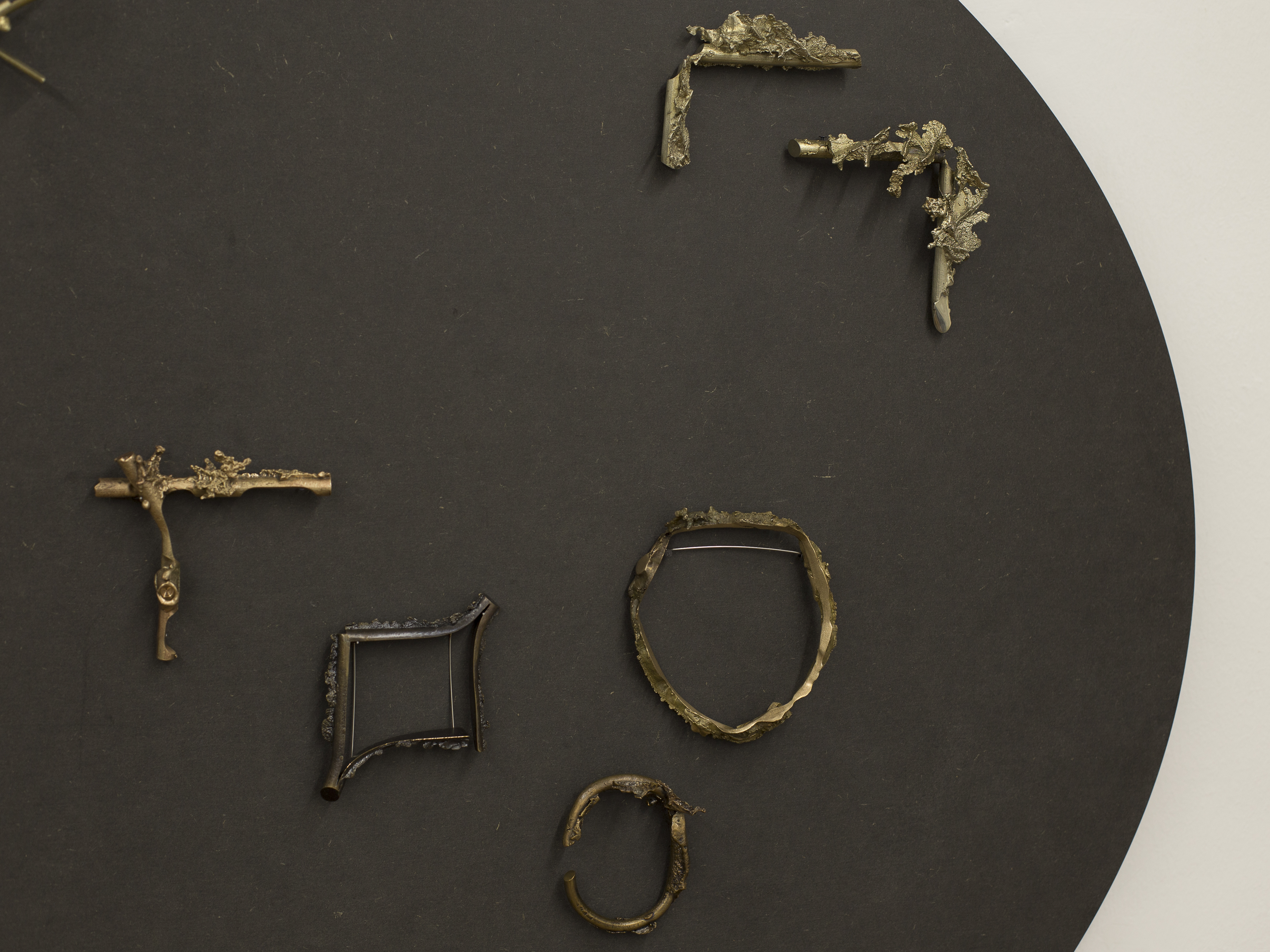
installation view, Maurer Zilioli Contemporary Arts gallery,
in room 2, MJW, Munich, DE, 2019
in room 2, MJW, Munich, DE, 2019

public collections:
• The Marzee Collection, NL, 2019
• Schmuckmuseum Pforzheim, DE, 2018
selected publications:
• SCHMUCKISMUS, Die Neue Sammlung,
Pinakothek der Moderne, catalogue, Munich, DE, 2019
• KORU 6, International Contemporary Jewellery,
catalogue, Imatra, FI, 2018
sponsored by Skulpturengießerei Knaak, Berlin, DE
• The Marzee Collection, NL, 2019
• Schmuckmuseum Pforzheim, DE, 2018
selected publications:
• SCHMUCKISMUS, Die Neue Sammlung,
Pinakothek der Moderne, catalogue, Munich, DE, 2019
• KORU 6, International Contemporary Jewellery,
catalogue, Imatra, FI, 2018
sponsored by Skulpturengießerei Knaak, Berlin, DE




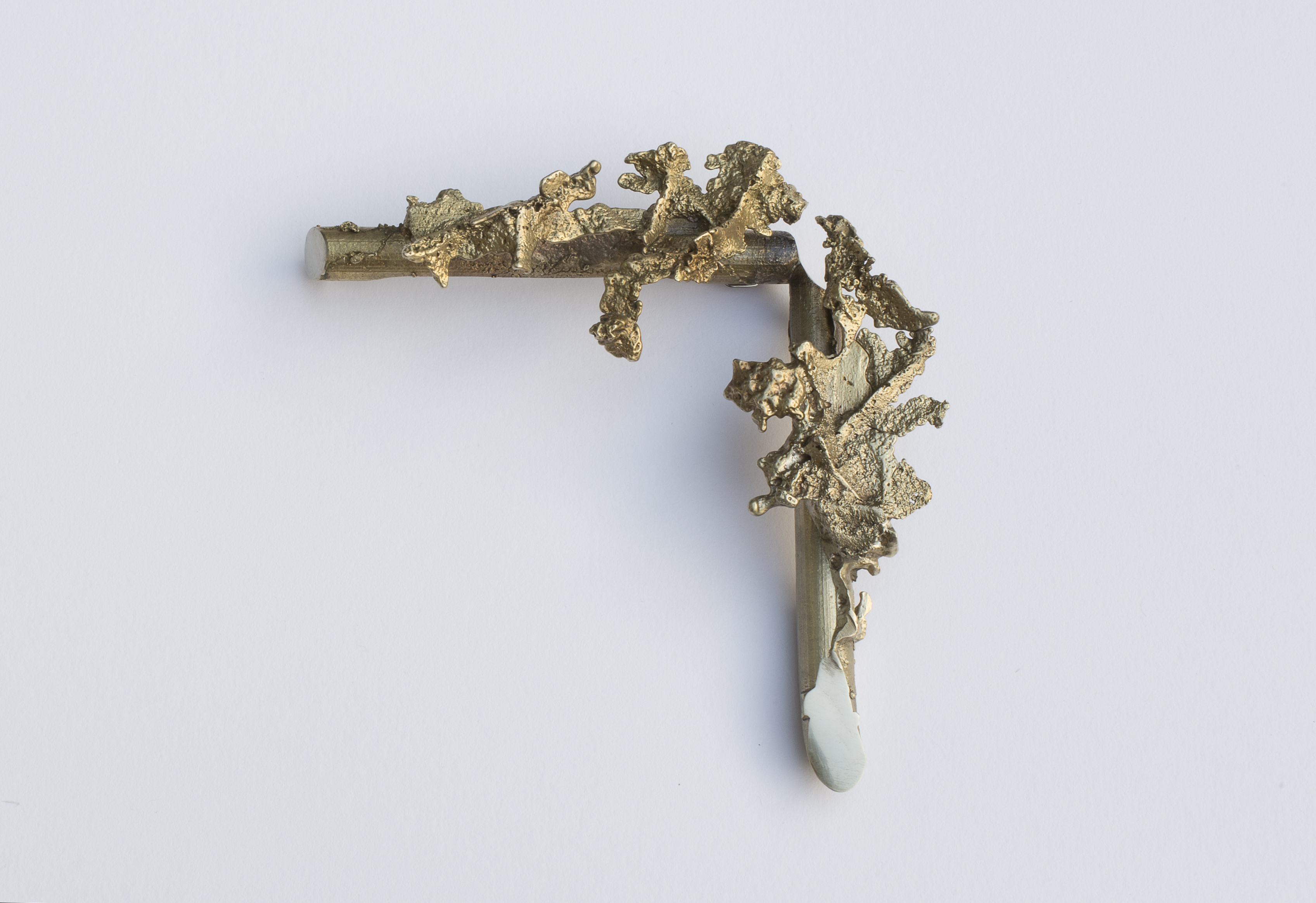


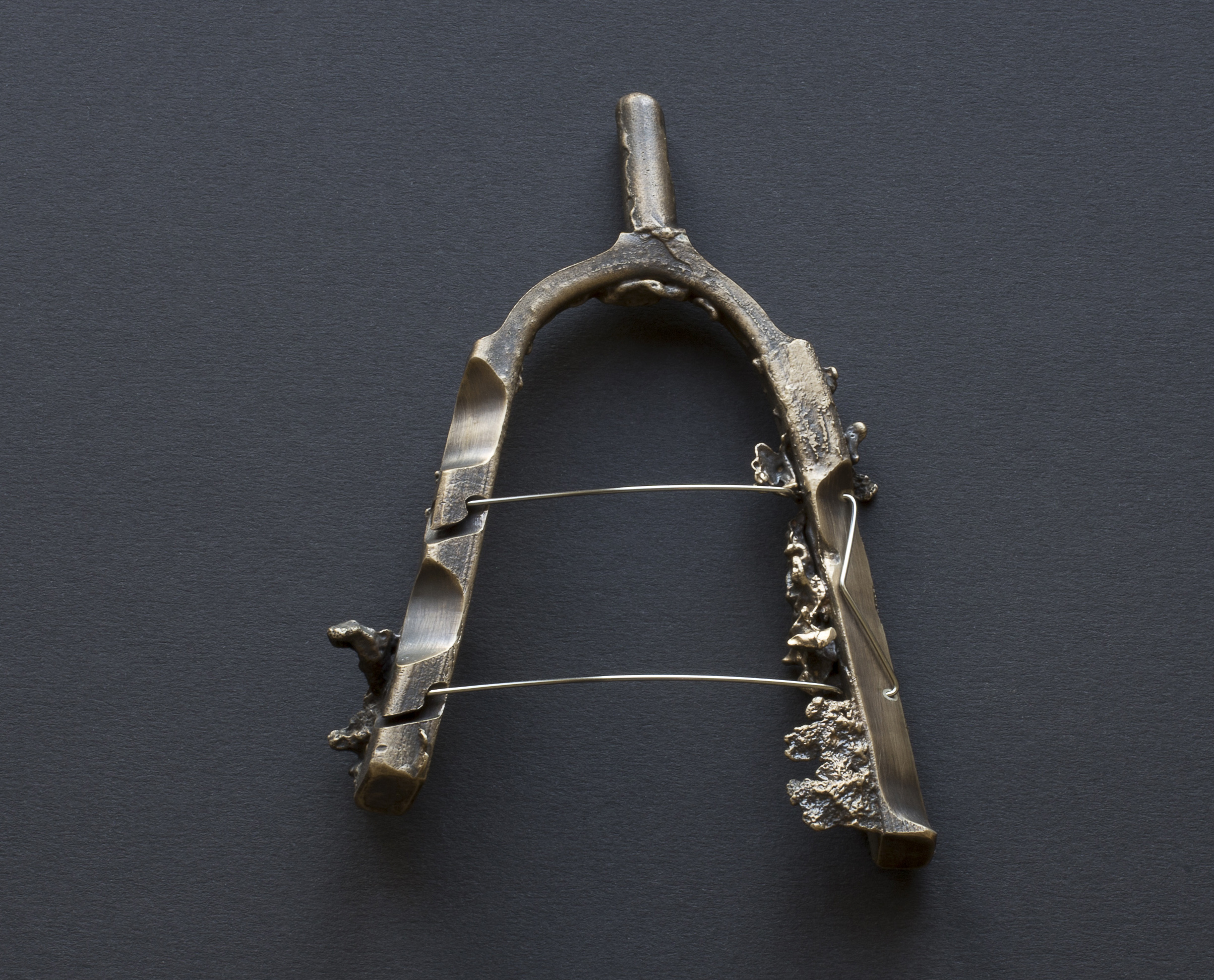



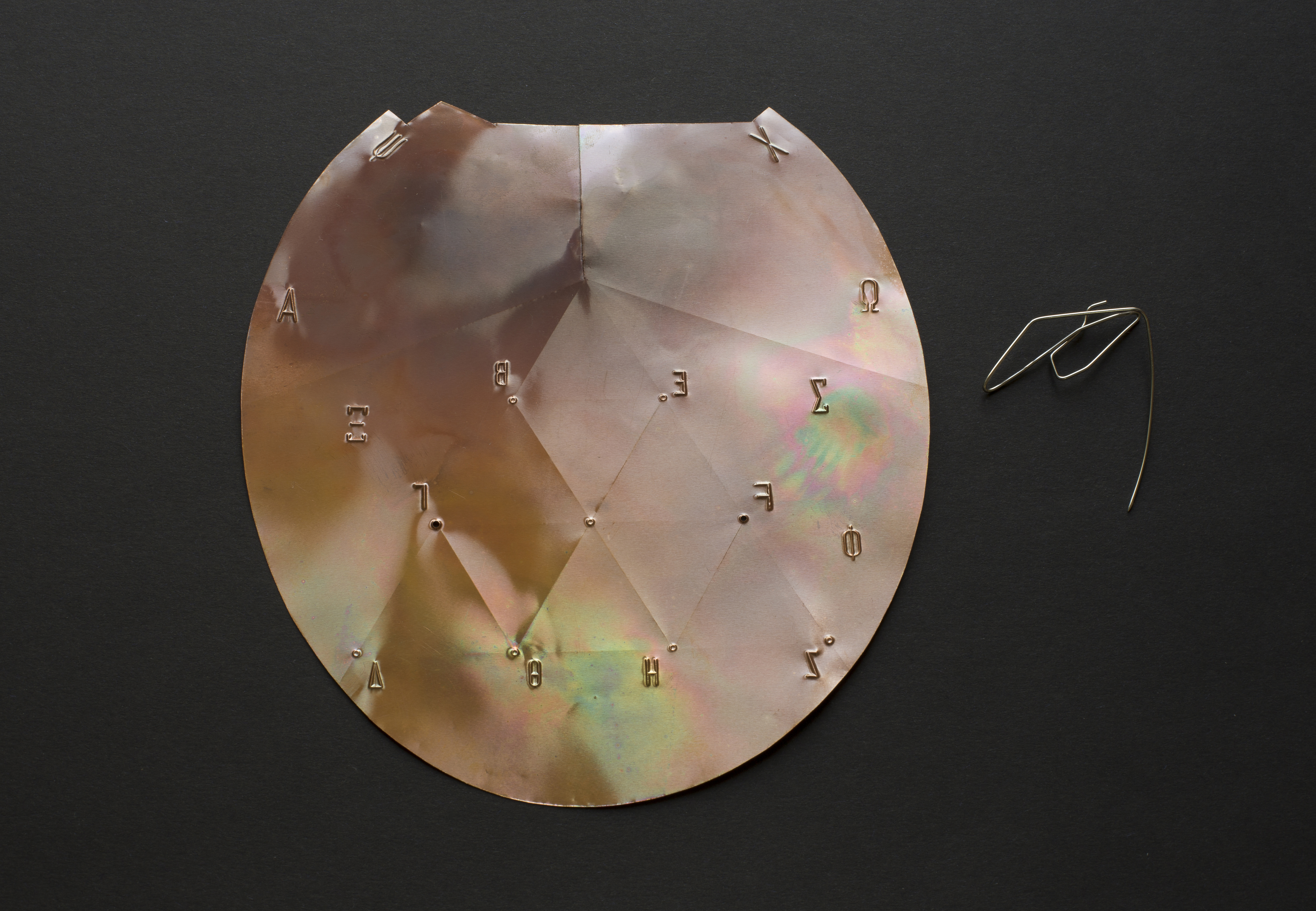
Omicron
2018
copper, stainless steel
The work “Omicron” was created in respose to the invintaion of curator Ruudt Peters to participate in the exhibition “21 Grams”,
which travelled to China, Germany, Poland, Belgium and Holland.
The title of the show originates from the scientific experiment, published in 1907 by Duncan MacDougall, a physician from Massachusetts,
who hypothesized that the soul has physical weight. Thus of 21grs.
“Omicron” was inspired by the notion of pseudoscience and the ancient cult of pythagoreanism, which believed that numbers were the basis of the entire cosmos,
structured according to significant mathematical relationships in order to achieve harmony.
Using the letters of the greek alphabet as numerical signs and by following an additive principle, they claimed to be capable of explaining the mysteries of life and death ...
The numeric values of each letter of a word were recursively added together to form an arithmetical sum. Words could be then linked back to their cosmic order.
I.e. the word ΨΥΧΗ (psyche=soul) gives the sum of 7, (Ψ=700, Y=400, X=60, H=8)
The piece does weight 21grs.
![]()
which travelled to China, Germany, Poland, Belgium and Holland.
The title of the show originates from the scientific experiment, published in 1907 by Duncan MacDougall, a physician from Massachusetts,
who hypothesized that the soul has physical weight. Thus of 21grs.
“Omicron” was inspired by the notion of pseudoscience and the ancient cult of pythagoreanism, which believed that numbers were the basis of the entire cosmos,
structured according to significant mathematical relationships in order to achieve harmony.
Using the letters of the greek alphabet as numerical signs and by following an additive principle, they claimed to be capable of explaining the mysteries of life and death ...
The numeric values of each letter of a word were recursively added together to form an arithmetical sum. Words could be then linked back to their cosmic order.
I.e. the word ΨΥΧΗ (psyche=soul) gives the sum of 7, (Ψ=700, Y=400, X=60, H=8)
The piece does weight 21grs.

What will kosmos say?
2013-2015
volcanic pumice stones, stainless steel
group of ≈ 100 brooches, exhibited complete or partly in several occasions

public collections:
• Schmuckmuseum Pforzheim, DE, 2015
• Cominelli Foundation Permanent Collection, IT, 2015
• Ilias Lalaounis Jewelry Museum, GR, 2016
selected publications & press:
• SCHMUCKISMUS, Die Neue Sammlung,
Pinakothek der Moderne, Munich, DE, 2019
• SCHMUCK 2017, official IHM catalogue, DE, 2017
• ART AUREA preview SCHMUCK 2017, issue #1-2017
• ITAMI International Craft Exhibition, catalogue
The Museum of Arts & Crafts ITAMI, JP, 2017
• Athens Jewelry Week, catalogue, GR, 2016
• Beijing International Jewelry Art Exhibition "Boundless", catalogue, CHN, 2015
• Edizioni Fondazione Cominelli, permanent collection catalogue, IT, 2015
• ART AUREA article, issue #2-2015
• GRASSIMESSE Leipzig, museum press release, 22.7.2014
installation view during MJW, Munich, DE, 2014
![]()
![]()
![]()
• AJF 10-Best Stand-Alone Pieces at Schmuck-Munich
• AJF 10-Most Exciting Juxtapositions at Schmuck-Munich
• AJF 10-Most Exciting Juxtapositions at Schmuck-Munich
installation view, Atelier Martina Dempf, Berlin, DE, 2016

exhibition view at
SCHMUCKISMUSDie Neue Sammlung, Munich, DE, 2019
Pinakothek der Moderne, The Design Museum

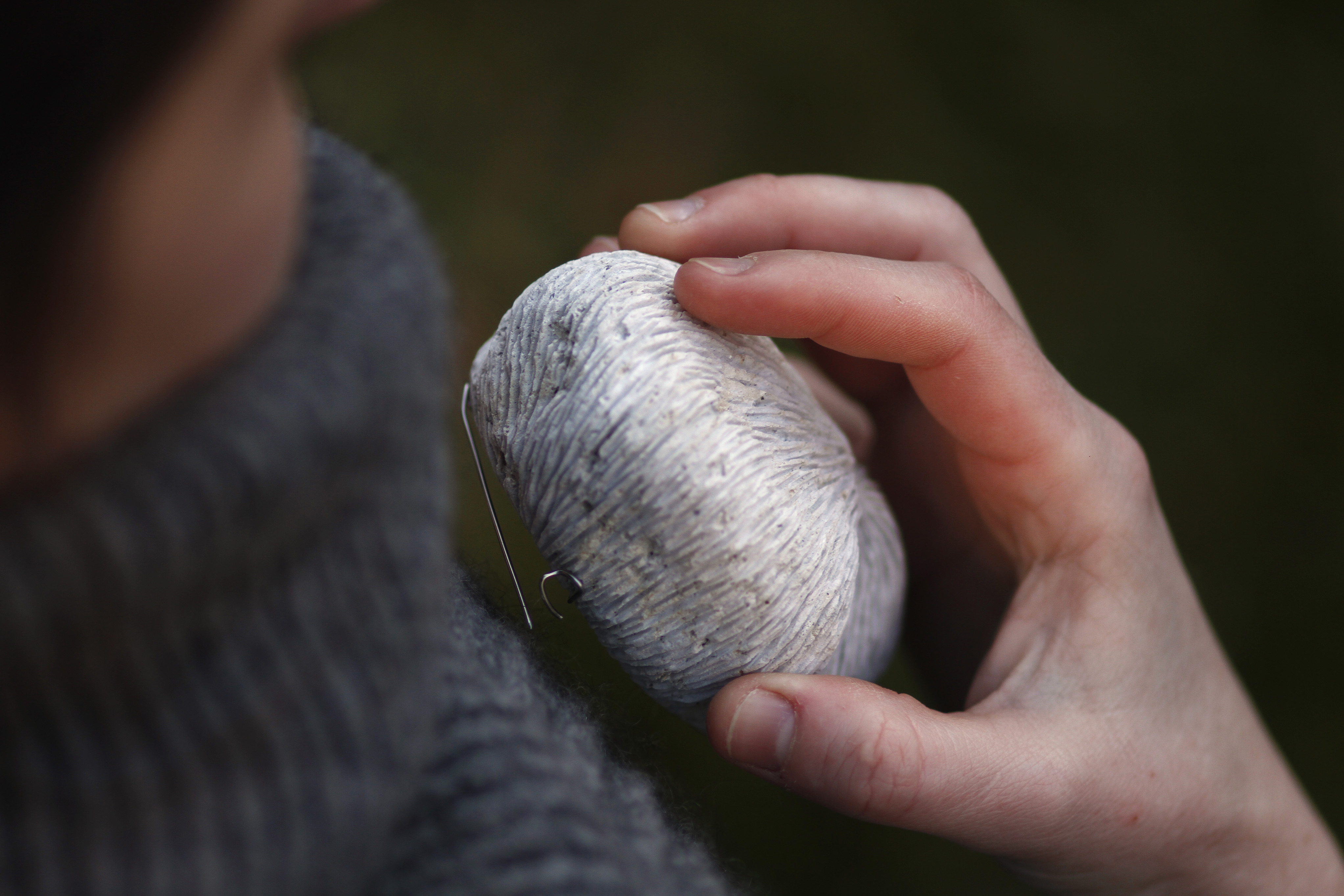
The current social/political struggles
emphasize the need to rethink and rebuild ways of operating within the society.
Only with theparticipation of the individuals and their active interaction can
eventually occur a change within the collective.
This work talks about the position of jewellery in times like these.
~•~
kosmos = the world = jewellery = the people
Kosmos has diverse definitions beyond the profound that relates to
notions of the universe or the world.
In the Greek language (κόσμος) it has the meaning of order, harmony or beauty.
In old Greek it stands also for jewellery and in neo-Greek usually means “the people”.
By reloading these meanings to the question, its impact changes.
It can evolve to “What will people say?” or “What will jewellery say?”
The title implies several interpretations and sets a bridge between
adornment, self-exposure and engagement in the public domain.
~•~
The brooches are made out of volcanic pumice rocks.
Pumice stones are super-heated, highly pressurized rocks, violently
ejected from a volcano millions of years ago. In 2013 the artist took
a special permission to visit the quarry on the island Yali/Greece,
where she collected the rocks one by one.
She sculpted and textured the surface of the stones by hand
and then hollowed out and assembled them according to their unique
measurements and proportions.
The most widely spread function of this mineral is the beautification
and cleaning of the human body. This custom denotes
the notion of“catharsis”.
Depending on context, catharsis (κάθαρση) can have a literal
connotation, as well as a metaphorical one. The latter can mean
“the purification or purgation of the emotions” primarily through
art, as used by Aristotle in the Poetics.
~•~
The brooches look up to that notion of catharsis.
But catharsis is most of all a condition.
Not a given answer.
It’s a process.
A process based on the idea that social and cultural reform can
occur through individual acts of resistance.
This work is inspired by the notion of the smaller parts working independently,
but also together, in order to reinforce a change within the whole.
Same as in the essence of the kosmos,
where the dependence of the whole upon the miniscule
is undeniable.
~•~
Jewellery is a powerful medium, because it demands involvement
and through this circular function it holds and transmits a statement.
Therefore jewellery is an active broadcaster within the public realm.
Jewellery as tool.
Creating a new kosmos by being this new kosmos in practice.
Making this choice everyday is essential.
An invitation to negotiate reality.
Thinking of jewellery not as an add-on, but as a put-out
2013 / Vivi Touloumidi







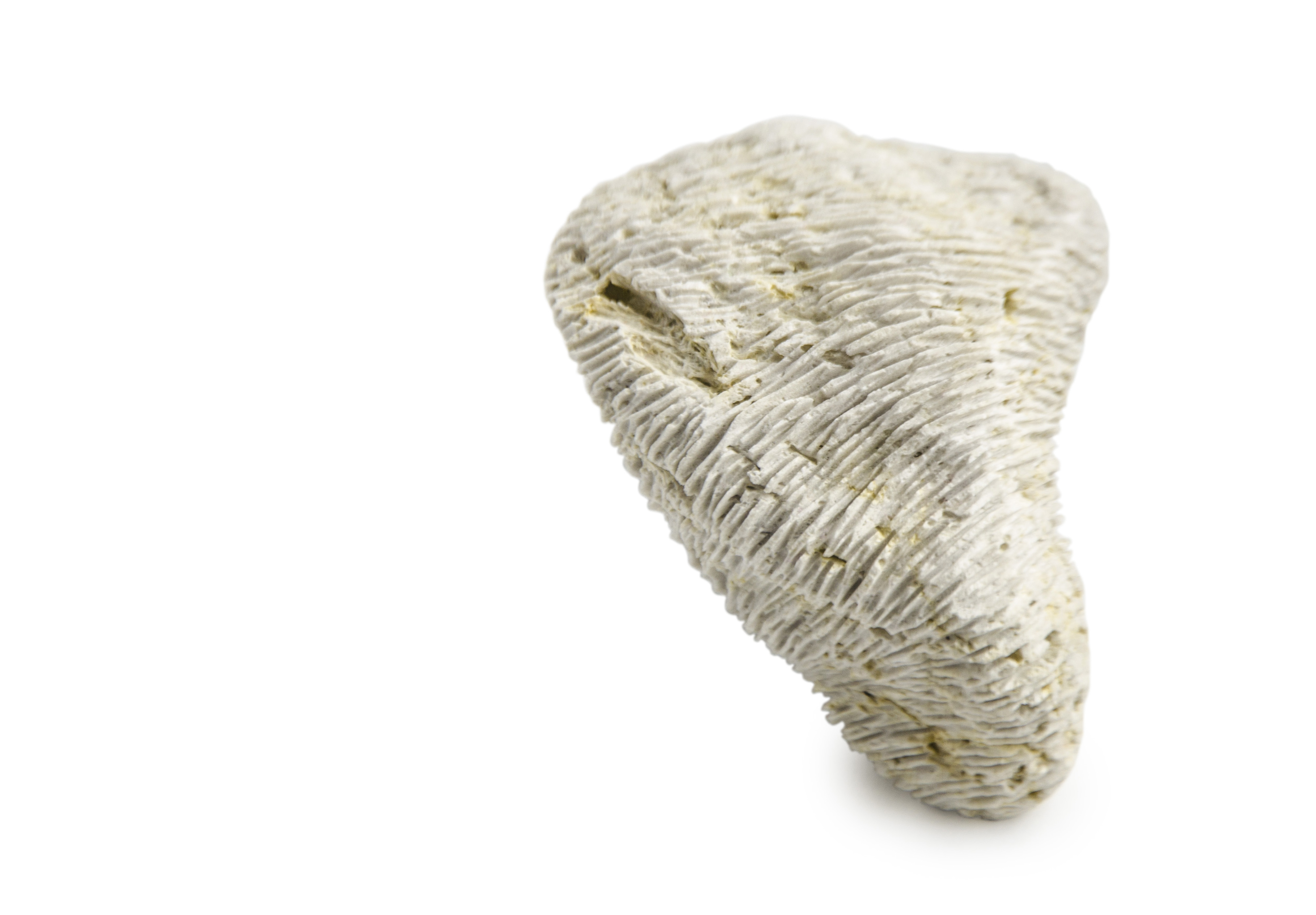
![]()
One
2012
cherry wood, iron nails, stainless steel
A group of 5 jewellery pieces, all substacted from one single block of cherry wood.
A making process resticted in one material of limited volume.
Every piece evolved from the remains of its former.
Each entity is the excess matter of the previous one.

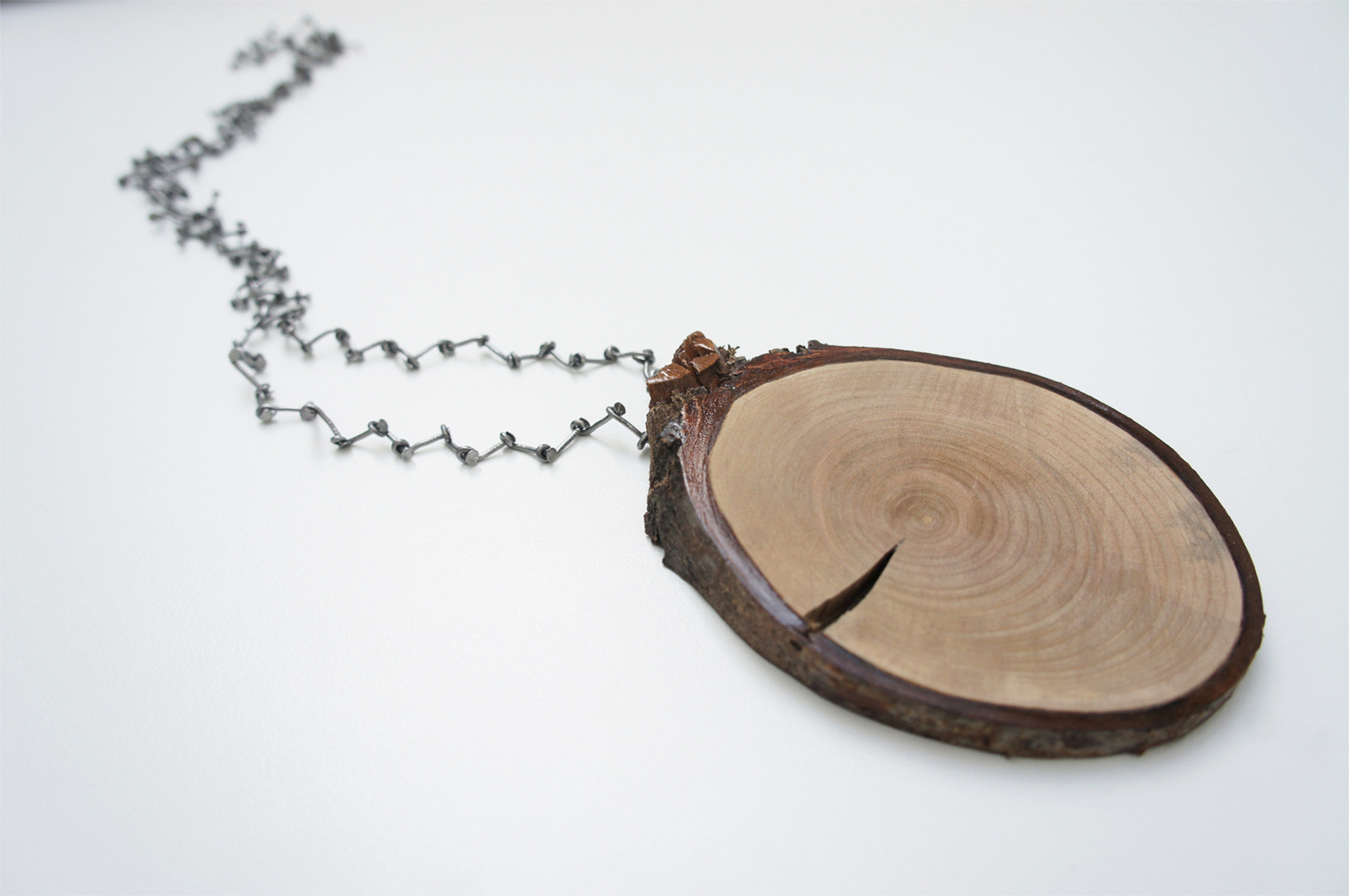
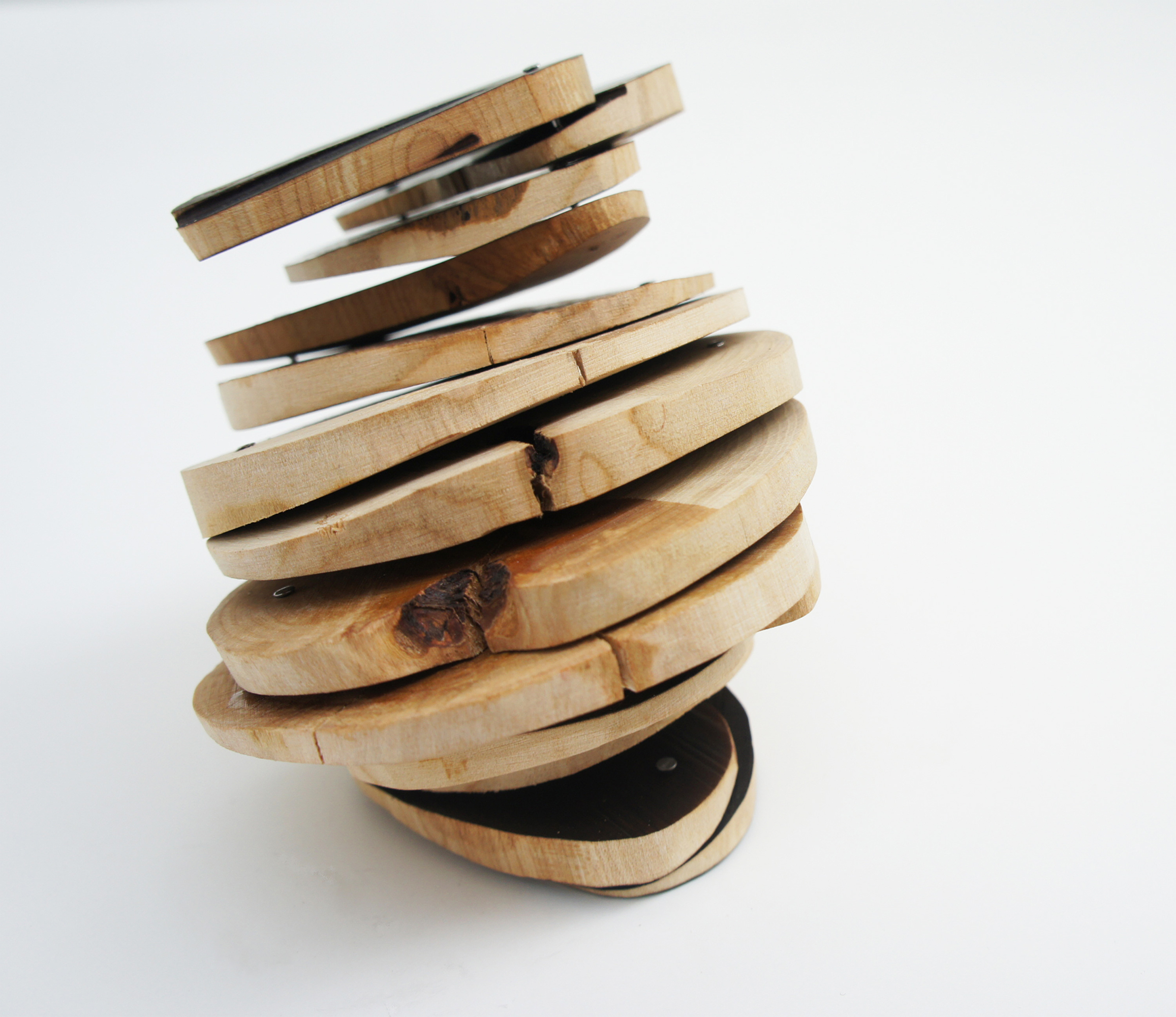


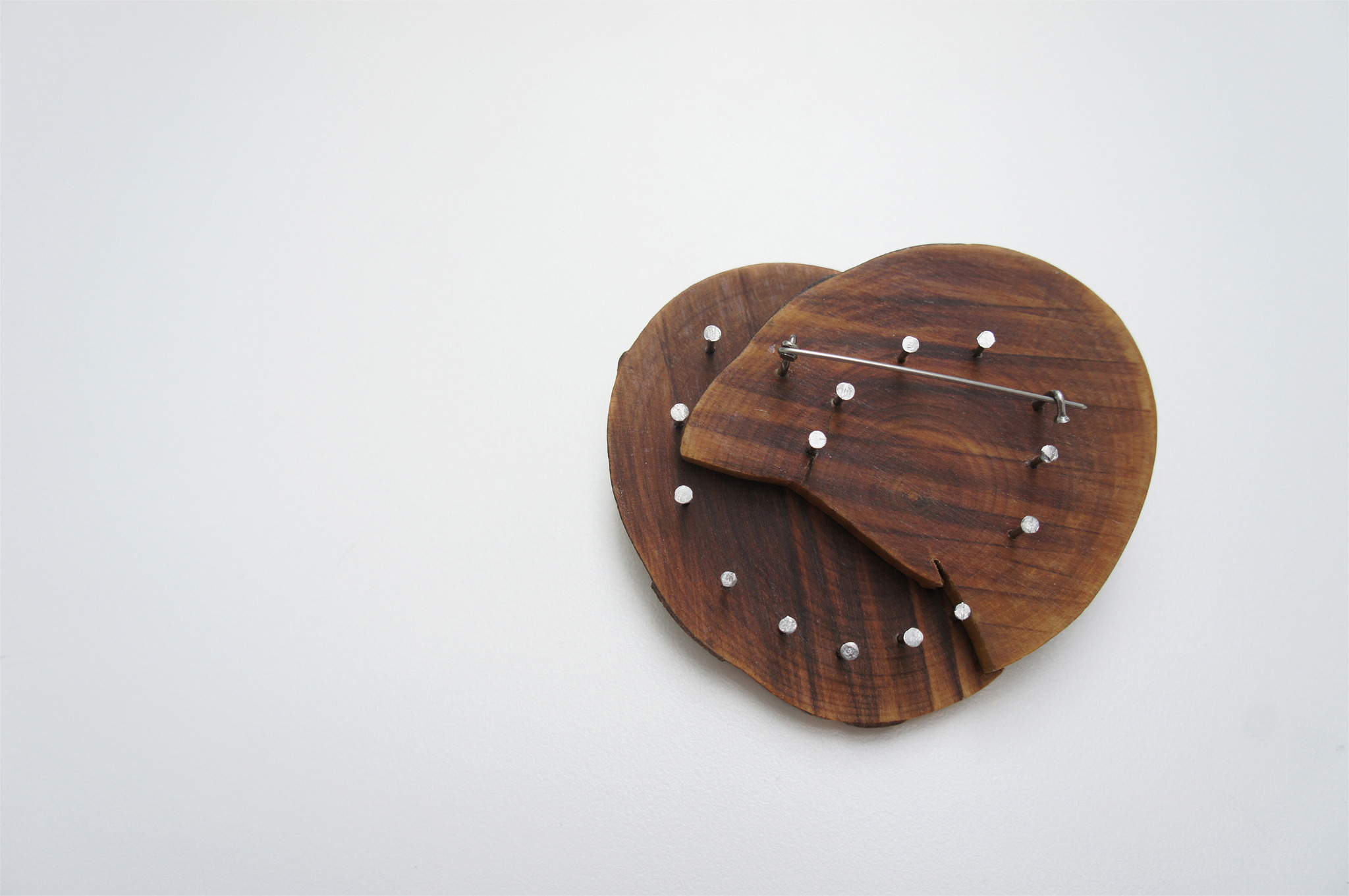
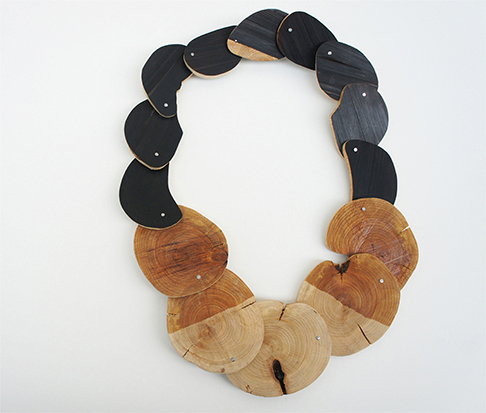


shown at “NATURE MORTE" traveling exhibition:
__ Vilnius Academy of Arts Gallery, Telsiai, LI
__ Amber Forum, Kaliningra, RU
__Ramybė gallery, Palanga, LI
__Legnica Jewellery Festival, Copper Museum, Legnica, PO

Medousas
2010-2012
fine silver, enamel, stainless steel
• in public collection of Schmuckmuseum Pforzheim, DE, 2012
• selected finalist Friedrich Becker Prize, DE, 2011
• catalogue: „Serpentina” Snake Jewellery from around the World,
Arnoldsche Art Publishers, Stuttgart, DE, 2011
